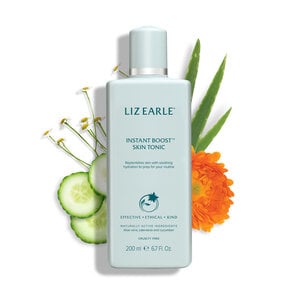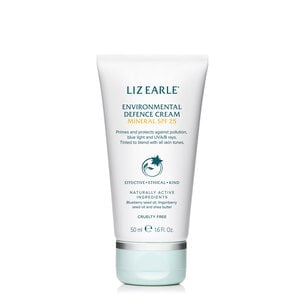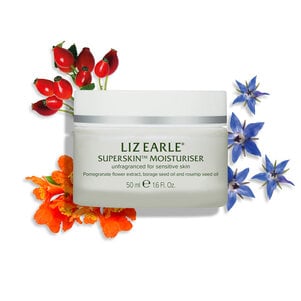
How to know if you have sensitive skin
May 9, 2024
3 min read
Determining whether you might have sensitive skin is an important first step in creating an effective skincare routine tailored to your skin’s unique needs. Although regular cleansing and moisturising are beneficial for all skin types, each type requires customised care. Sensitive skin can manifest in various ways, from the appearance of redness and irritation caused by adverse reactions to certain products or environmental factors.
What are the different skin types?
Skin types can vary significantly from person to person, influenced by genetics, environmental factors and individual characteristics. Skin can be classified into five main types: oily, dry, combination, sensitive and normal. The basis for determining this is how much water your skin retains, how oily it is and how sensitive it is. Bear in mind your skin can also be sensitive with all of the other types.Normal skin typically has balanced moisture levels, isn't overly oily or dry, and is generally looks clear with small pores. Oily skin tends to produce excess sebum – an oily substance that protects your skin from drying out – leading to a shiny complexion, visibly enlarged pores, and more prone to the appearance of blemishes and blackheads. Dry skin lacks sufficient moisture, often appearing dull, rough, and flaky, with fine lines and wrinkles looking more pronounced. Combination skin is where there are areas of both dryness and oiliness, with an oily T-zone (forehead, nose, and chin) and drier cheeks. Sensitive skin may be left feeling uncomfortable by various factors such as certain skincare products, weather conditions, or environmental pollutants, leading to redness, itching or discomfort.
What is sensitive skin and what does it look like?
Sensitive skin is a common skin type where skin is more prone to reactions, often leading to skin feeling irritated and uncomfortable. It occurs in some people due to a genetic difference in the skin barrier, or from external irritants that may trigger an adverse reaction. The visible signs of sensitive skin can vary widely among individuals, but common visible signs include the skin looking and feeling red, dry, flaky and reactive. People with sensitive skin may notice that their skin reacts strongly to certain skincare products that can damage the outer layer of the skin, such as soaps, hand sanitisers and laundry detergents, as well as other external factors such as environmental pollutants and weather changes.
Those with sensitive skin may be prone to conditions such as eczema, rosacea or contact dermatitis, which can further worsen its appearance. Unlike other skin types, sensitive skin tends to react negatively to harsher ingredients, fragrances and more abrasive treatments, making it hard to find suitable skin solutions. Managing sensitive skin requires a sensitive skin routine that uses a gentle approach such as, using hypoallergenic, fragrance-free products, avoiding very hot showers and steering clear of known triggers to help minimise irritation and maintain healthy-looking skin.
How to identify if you have sensitive skin
Identifying sensitive skin involves recognising specific visible signs and reactions due to certain external and internal factors. One of the most common indicators is the appearance of redness or flushing, particularly in response to skincare products, environmental triggers like sun exposure or extreme weather conditions.
Another way to identify sensitive skin is by observing how it reacts to different skincare ingredients – if your skin tends to react after using new products, it may indicate you have sensitive skin. Introducing new skincare products gradually and carrying out patch tests can help. To conduct a patch test, apply a small amount of the product to a discreet area and leave on as long as the product would normally be on the skin for. Monitor for any adverse reactions, such as, the appearance of redness and feelings of discomfort. This method allows you to assess your skin's tolerance to specific ingredients and formulations, enabling you to make informed decisions about product suitability.
Consulting with a dermatologist or skincare professional can provide further insights and guidance in confirming and managing sensitive skin effectively.
Step-by-step routine for sensitive skin
It can be hard to shop for for skincare for sensitive skin, however Liz Earle Beauty has a selection of sensitive skincare options. Our Pro-Biotic collection offers deeply nourishing fragrance-free formulas that instantly soothe reactive-feeling skin, helping to strengthen the skin’s moisture barrier.

Step One: Cleanse
Start with our Pro-Biotic Balancing Milk Cleanser for sensitive skin, as it effectively cleanses without stripping your skin of its natural goodness, leaving even the most dry, sensitive and reactive-feeling skin looking calmer, clearer and healthier.

Step Two: Tone
Follow with our Instant Boost™ Skin Tonic Toner for sensitive skin to refresh to refresh, soothe and brighten the appearance of skin. Powered by aloe vera to hydrate, chamomile and cucumber to soothe and refresh, plus vitamin E, leaving skin looking radiantly healthy.

Step Three: SPF
No matter your skin type, an SPF should be worn every day to protect against sun damage. Our Environmental Defence Cream Mineral SPF 25 primes and protects for visibly healthy-looking skin. Formulated with naturally derived mineral UV filters and antioxidant plant extract, this lightweight cream protects skin from UVA and UVB rays, blue light and pollution, priming it for the day ahead.
Step Four: Moisturise
For the day, turn to our intensely nourishing moisturiser, Superskin™ Moisturiser unfragranced, for sensitive skin. Packed with powerful plant ingredients, this luxurious blend delivers up to 72 hours of hydration. For the evening, our ultra-gentle Pro-Biotic Balancing Night Cream helps revive stressed-feeling skin while you sleep, so you awaken to skin looking radiant and renewed.SHOP THE PRODUCTS




